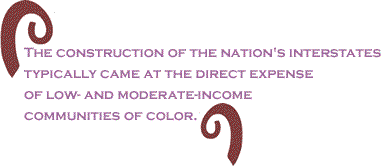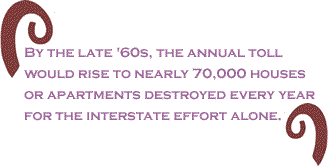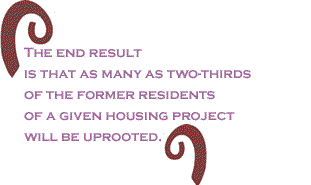| 
Two pieces in my local paper today served as a clear
reminder of the old adage that there is more than one side to every
story. So too, they confirmed the wisdom – however much maligned
it may be it by some – that truth is often contingent upon one's
perspective, rather than being something we can determine objectively.
First, consider an opinion piece, written by Butch Eley, the CEO
of a Highway Maintenance company. Therein, Eley lauds the nation's
Interstate Highway program: an effort that celebrates its 50th anniversary
this month, and which continues apace, as the perpetual construction
projects around the country – which show no sign of ever reaching
completion – clearly attest. To the column's author, the interstate
program has been an unqualified success, linking communities to
one another, and helping families remain mobile, making relocation
or visits to relatives quicker and easier than ever. Eley praises
the 46,500 miles of "superhighways" dotting the continental
U.S. as "an essential part of our lives and an unquestionable
contribution to our quality of life"
And while I would certainly agree with Eley that the nation's interstates
have contributed to economic growth, the costs paid for development
and economic expansion have been considerably greater than he would
have us believe. For now, I won't even speak of the way interstates,
built at the behest of the automobile lobby, destroyed mass transit
– benefiting largely the haves at the expense of the have-nots.
And I'll put to the side the problems associated with over-reliance
on cars, such as increased air pollution, energy costs, oil dependence,
and residential sprawl, with its attendant long commutes and associated
road rage. Instead, I'll focus on another, underappreciated but
significant matter: namely, that the construction of the nation's
interstates typically came at the direct expense of low- and moderate-income
communities of color, whose neighborhoods, homes and businesses
were often destroyed to make way for all that "progress."
That Eley doesn't think about that isn't surprising: his company,
after all, is based in Brentwood, Tennessee – a prototypical white
flight suburb if ever there was one – far from the North Nashville
community that was torn apart by Interstate 40 in the late 1960s.
Butch has probably never been there, or even if he has, he likely
hasn't been told of how the interstate helped choke the economic
lifeblood out of this place so close to (and yet so far from) his
own home.

Of course, North Nashville wasn't the only place
impacted by the highway program. As University of Alabama History
Professor Raymond Mohl has noted, by the early 1960s, more than
37,000 urban housing units each year were being demolished to make
way for interstate construction: this, on top of another 40,000
or so being knocked down as part of "urban renewal" –
which typically meant the creation of parking lots, office parks
and shopping centers in working class and low-income residential
spaces. By the late '60s, the annual toll would rise to nearly 70,000
houses or apartments destroyed every year for the interstate effort
alone. Of residents displaced, approximately three-fourths were
African Americans, and large shares of the remainder were Latino
– especially Puerto Ricans in large Northern cities.
Less than ten percent of persons displaced by urban renewal and
interstate construction had new single-resident or family housing
to go to afterward, as cities rarely built new housing to take the
place of that which had been destroyed. Instead, displaced families
had to rely on crowded apartments, double up with relatives, or
move into run-down public housing projects.

Indeed, displacement was no coincidence or mere unintended
consequence of the highway program. To the contrary, it was foreseen
and accepted as a legitimate cost of progress. In 1965, for example,
a Congressional Committee acknowledged that the highway system was
likely to displace a million people before it was finished. This
displacement was not only expected, but indeed it was championed
as a way to "clear  out"
black and brown ghettos. The American Road Builders Association
– a lobby with obvious interests in the creation of tens of thousands
of miles of interstates – praised the construction as a way to eliminate
"slum and deteriorated areas," thereby countering the
"threat posed by slum housing to the public health, safety,
morals and welfare of the nation." One federal official even
admitted in 1972 that the interstate program was seen as a good
way to "get rid of the local niggertown.” out"
black and brown ghettos. The American Road Builders Association
– a lobby with obvious interests in the creation of tens of thousands
of miles of interstates – praised the construction as a way to eliminate
"slum and deteriorated areas," thereby countering the
"threat posed by slum housing to the public health, safety,
morals and welfare of the nation." One federal official even
admitted in 1972 that the interstate program was seen as a good
way to "get rid of the local niggertown.”
But there was a problem for those persons being cleared out: due
to racial discrimination in suburban and outlying areas, persons
of color displaced in this fashion had nowhere to turn for housing.
Certainly the white builders, developers, and others who supported
the destruction of so-called slums, weren't thinking of challenging
the blatant racism in lending or zoning that was keeping their suburban
spaces all-white. In fact, at the same time black and brown housing
was being destroyed, millions of white families were procuring government
guaranteed and subsidized loans (through the FHA and VA loan programs),
that were almost entirely off-limits to people of color. So, ironically,
the government was reducing the housing stock for people of color
at the same time it was deliberately expanding it for whites: and,
in fact, since the interstate program made "white flight"
easier and cheaper than ever before, it can even be said that white
middle-class housing access was made possible because of the destruction
of housing for African American and Latino communities.

So rather than eliminate slums, the interstate program
facilitated their worsening – causing black and brown neighborhoods
to become even more cut off from the rest of their respective cities,
as highways cut through the hearts of their communities, negatively
effecting commerce in the place where it was needed most.
In New Orleans, for example – and take note of it, all those who
thought Katrina's displacement of black folks was unique, or who
have chosen to blame the black community there for the condition
of its neighborhoods – the I-10 sliced and diced through the main
artery of two of the city's largest black communities: the Tremé
and the Seventh Ward.
The Tremé--the oldest free black community in the
United States – was (still is) bordered on one side by Claiborne
Avenue, above which the I-10 would be constructed. The Claiborne
corridor was home to as many as 200 black-owned businesses in its
day, and included a wide median (known to locals as a "neutral
ground"), lined with huge oak trees and plenty of space for
recreation, community picnics, family gatherings and cultural events.
Once completed, the I-10 had destroyed what was, for all intent
and purposes, a public park 6,100 feet long and 100 feet wide, along
with hundreds of business and homes. In the Seventh Ward, home to
the city's old-line Creole community, residents saw the same kind
of devastation, also from the construction of the I-10 along Claiborne,
including the virtual elimination of what was once the nation's
most prosperous black business district.
The destruction of urban residential space prompted citizen protests
across the nation: in the South (Miami, Montgomery, Columbia, Birmingham,
Charlotte, Tampa, Jacksonville, Orlando, and Atlanta, in addition
to Nashville, previously mentioned), the North (South Bronx, Pittsburgh,
Baltimore and Camden, NJ), the Midwest (Kansas City, St. Paul, Indianapolis,
Columbus, Cleveland, Milwaukee and Chicago), and the West (Los Angeles,
Pasadena, and Seattle). In fact, opposition to many of the proposed
interstate routes forced the government to pass new regulation in
the late 60s, ostensibly ensuring relocation assistance or new housing
construction to replace units destroyed: a promise that would go
largely unfulfilled in each and every community affected.
Given the government's steadfast refusal to offer relocation assistance
in the face of intentional housing stock reduction - and indeed
the head of Eisenhower's Office of Economic Advisors admitted relocation
help was rejected as being too costly – it can truthfully be said
that the interstate program operated as a mechanism of racial apartheid
and oppression for millions of people: a none-too-minor factor quite
typically overlooked by the likes of Butch Eley in their glowing
paeans to white middle-class "progress."
Which brings us to a second, and not unrelated story, also about
housing availability or the lack thereof in low- and moderate income
communities of color. In the local section of my paper today, one
finds a story about the redevelopment of the Sam Levy homes, from
a former low-rise public housing project, to a new mixed-income
housing community, under the financial tutelage of the federal HOPE
VI program. HOPE VI, according to the piece, has breathed new life
into the Sam Levy community, providing attractive duplexes for residents
in place of the previous maze of dilapidated row apartments. And
by economically mixing the neighborhoods where they intervene –
one third public housing, one-third subsidized voucher housing for
persons with slightly higher incomes, and one-third market rate
renters and owners – HOPE VI proposes to revitalize urban spaces,
such as the East Nashville community where the Levy homes once sat.

Once again, as with the praise for the interstate
system, there is some truth to the conventional wisdom on HOPE VI.
Having seen the pastel, well-designed homes that have replaced the
projects in Levy, I can certainly vouch for what an improvement
the enterprise will be for those who will be living there. For those
residents of Levy who are able to return, life will be immeasurably
better: less crowding, likely less crime, and (no pun intended)
likely more hope for their future and the future of their children.
But what of those who don't make it back? What will happen to them?
After all, HOPE VI developments almost always result in a net reduction
of affordable housing: rebuilding as few as one-tenth the number
of units as before. Then, since at least one-third of the units
rebuilt will be put on the open market, ultimately lived in by those
who could afford to live elsewhere – and another third will be for
those who need small rent subsidies but would likely not have lived
in public housing before – the end result is that as many as two-thirds
of the former residents of a given housing project will be uprooted.
Nationally, as few as eleven percent of displaced public housing
residents have been slated for re-occupation in HOPE VI developments.
Although the HOPE VI program, administered by the Department of
Housing and Urban Development (HUD) vows to provide housing vouchers
to displaced residents who "choose" not to return to the
new development (or, in most cases are priced out of the area, or
screened out due to bad credit and other factors), the truth is
that very few end up receiving vouchers. In fact, residents are
nearly sixty percent more likely to simply be shuffled into another
public housing project, than to receive a voucher allowing them
to move up and out of concentrated poverty – the ostensible purpose
of HOPE VI in the first place.
Approximately one in five public housing residents
displaced by HOPE VI lose all housing assistance, and are left to
fend for themselves. With no tracking mechanism to keep up with
families, how they're doing, and what their needs may be, this means
that tens of thousands of extremely poor persons are falling through
the cracks, even as thousands more see their lives improved.
So while mixed-income housing remains a laudable theory (and indeed,
I for one would love to see all neighborhoods be zoned for mixed
use – including the affluent lily-white suburbs), the fact remains
that so long as poor communities are asked to make room for more
affluent buyers, while affluent communities aren't expected to make
room for the working class and poor, programs like HOPE VI will
only intensify the nation's affordable housing crisis. Thus far,
HOPE VI has resulted in the demolition of over 70,000 public housing
units in the nation – part of an overall reduction in public housing
stock of nearly 200,000 units since the 1970s – leading to wait
lists in some communities that are as long as eight years.

That such a situation should concern us all is obvious:
after all, if affordable housing stock is reduced in a given community,
demand for higher-cost market rate housing intensifies, driving
up the price for everyone. Even the property owners who benefit
in the short term from a run-up of their equity value may come to
regret the destruction of lower-cost housing, since the overvaluation
of property inevitably results in a housing bubble, likely at some
point to burst. When prices rise to such an extent that they become
unrealistic for middle-income homeowners and renters, even affluent
owners may feel the pinch as values stagnate or ever begin to slide
a bit. In this way, affordable housing stabilizes prices over the
long run, and to lose such units poses a significant threat – first
to the poor and working class, but ultimately to most everyone:
even those like the Mayor of Nashville and the developers, who praise
such progress from behind the uncritical veil of their own short-term
perspective.
That federal and local officials have opted to create mixed income
communities by running off poor folks and importing the middle class,
as opposed to spending the same monies to provide better job opportunities
for the folks in those communities to begin with - thereby mixing
up the local income picture from within - says a lot. It suggests
that at some level, we have given up on the ability of poor people
to take advantage of opportunity, once afforded to them. It suggests
that we think the only hope is for poor people to be around middle
class folks, as if middle class values (which aren't, frankly, all
they're cracked up to be) will rub off. It suggests that we've accepted
the conservative line that the problem with poor people is internal,
rather than systemic: that somehow role models are more important
than living-wage jobs and decent schools.
And so long as we accept that kind of thinking, the kinds of problems
faced by the poor and working class in this country - especially
but not only people of color - will remain, whether or not they
receive the kinds of media attention reserved for signs of so-called
progress.
Tim Wise is the author of White Like Me: Reflections on Race
from a Privileged Son (Soft Skull, 2005), and Affirmative
Action: Racial Preference in Black and White (Routledge, 2005).
He can be reached at [email protected], where you
can also find a footnoted version of this article. |








































